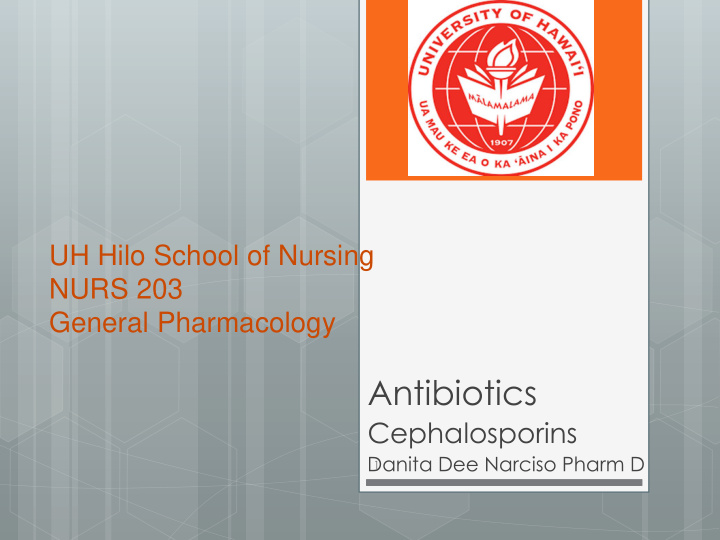



UH Hilo School of Nursing NURS 203 General Pharmacology Antibiotics Cephalosporins Danita Dee Narciso Pharm D 1
2 Objectives Become familiar with antibiotics that are commonly used and recognize areas of potential practical conflicts Recognize antibiotics that have interactions with other medications or illnesses Learn how to monitor for and adjust for changes in drug levels due to interactions with antibiotics
3 Cephalosporins
4 Cephalosporins Bactericidal vs. bacteriostatic MOA Bind to PBPs, in doing so the drug damages the cell wall, daughter cells have damaged cell walls that lead to cell death Time dependent killing The bacteria’s defense Beta-lactamases Changes in PBPs
5 Frist generation Oral – Cephalexin, cephazolin, cephradine, and cefdroxil (not for serious infection) Most activity against gram positive cocci Cephalexin (Keflex) Uses: Respiratory tract infections, otitis media, UTI, endocarditis prophylaxis ADRs: agitation, confusion, dizziness, fatigue, and headache (others – rash, GI distress) Allergy Parenteral - Cefazolin
6 Second generation (Carbecephems & Cephamycins Oral – Cefaclor, cefuroxime, cefprozil, loracarbef, and others Activity against the organisms susceptible to 1 st generation drugs with additional gram negative coverage Cefuroxime (Ceftin) Uses: Respiratory tract infection, UTI, otitis media, & uncomplicated gonorrhea ADRs: Diarrhea, diaper rash, nausea/vomiting, vaginitis Allergy Can cross the blood brain barrier but not as effective as other agents
7 Third generation Oral – Cefixime, cefdinir, cefpodoxime, ceftibutin Has greater coverage of gram negative organisms than the 2 nd gens but decreased effectiveness for gram positive Ceftriaxone (Rocephin) Ceftazidime (Fortaz) Uses: Community acquired pneumonia, exacerbations of chronic bronchitis, bacterial otitis media, sinusitis, and pharyngitis/tonsillitis ADRs: Diarrhea, rash, headache Allergy
8 Fourth generation Cephepime (Maxipime) Improved coverage over 3 rd generation products More resistant to beta-lactamases ADRs - > 10 % hematologic
9 Fifth generation Ceftaroline (Teflaro) Limited use ADRs - > 10 % hematologic
10 Ceph - Kinetics Absorption GI tract or given parenterally, food decreases the rate of absorption but not the amount (except cefuroxime & cepodoxime) Distribution Widely distributed - including placenta Cross BBB – Cefuroxime, third, and fourth gens Metabolism Renal Cetriaxone – renal and biliary (no renal dosing) Elimination Unchanged in the urine Ceftriaxone – stool (to a small extent)
11 Adverse drug reactions GI disturbances Diarrhea, nausea, vomiting Dermatologic Rash and redness CNS Agitation, anxiety, seizure, confusion, and behavioral changes Increased risk of bleed (ceftriaxone and some others) Be aware of when a patient started their antibiotic Are you starting a new med or changing doses?
12 Drug-drug interactions Acute alcohol intolerance Oral contraception Uricosurics (Gout relief agents)
13 Allergy There is a cross sensitivity between penicillins and cephalosporins Avoid if previous exposure caused anaphylaxis An allergy to cephalosporins Hives, itching, measles-type rash, serum sickness
14 Questions ?????????????????????????????????? ?????????????????????????????????? ?????????????????????????????????? ?????????????????????????????????? ?????????????????????????????????? ?????????????????????????????????? ?????????????????????????????????? ?????????????????????????????????? ??????????????????????????????????
Recommend
More recommend